Search engine optimization helps people find your business online. It brings the right visitors to your website and makes sure your content shows up when potential customers search for solutions. In 2025, SEO plays an even bigger role, as search engines like Google and Bing rely on AI to decide what content appears and what doesn’t. These engines prioritize structure, topical authority, and clarity – the core elements of a strong SEO strategy.
We show you how SEO works today and how to build a strategy that scales. You’ll learn the core principles behind search visibility, our 7-step execution framework, the most common mistakes to avoid, and how AI and generative engines are reshaping search. Everything we share reflects how we work at Dok Online – with a focus on long-term growth and search authority that sticks.
What is Search Engine Optimization?
SEO stands for Search Engine Optimization, which is the process of improving your website so that it ranks higher in major search engines.
At its core, SEO rests on three pillars: on-page optimization, technical performance, and off-page authority. Each pillar supports a different part of how search engines evaluate and rank web pages. When these three work together, they show search engines that your content is relevant, accessible, and trustworthy.
If you’re looking for a guide to SEO that works across industries, this is where it starts. Whether you’re running an ecommerce store, managing a B2B platform, targeting local customers, or expanding internationally – your strategy builds on the same SEO principles.
This structure also supports the shift toward Generative Engine Optimization (GEO), helping brands show up in AI-driven results like Google SGE. As search continues to evolve, SEO remains the starting point. Without it, visibility in modern search simply isn’t possible.
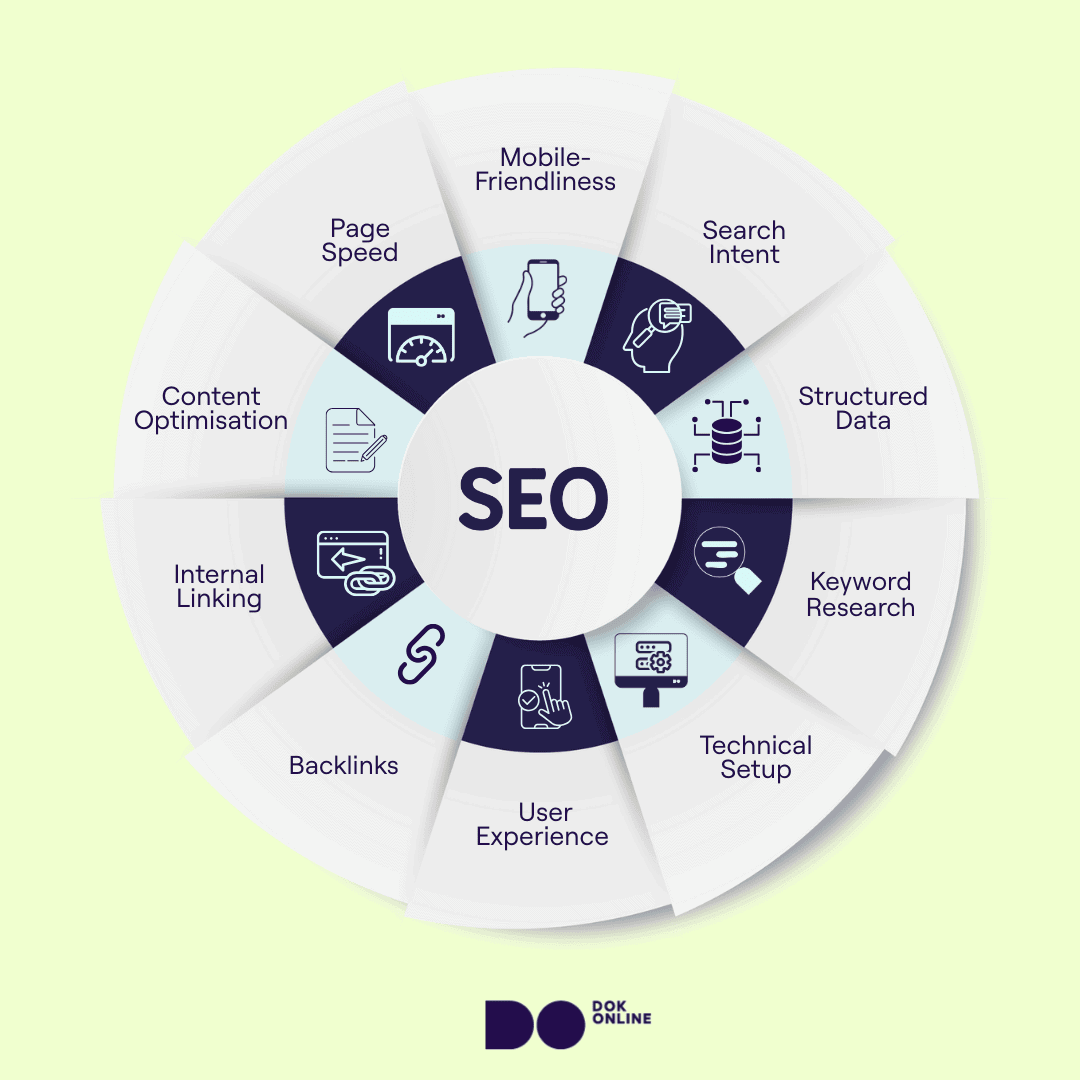
How does Google decide what site to rank?
Google ranks websites by evaluating how well each page matches a search. It starts by crawling your site to discover content, and then indexing the pages it finds. Once a page is in the index, the algorithm ranks it based on a wide range of signals – known as ranking factors – that measure relevance, structure, trust, and usability. Google has over 200 search ranking factors and we don’t know how much importance is assigned to each of them.
To make these decisions more accurate, Google’s systems have evolved significantly over time. Updates have shifted the focus from surface-level tactics to deeper measures of content quality, meaning, and trust:
- Panda & Penguin penalized low-quality content and manipulative link tactics, raising the standard for relevance and trust.
- Knowledge Graph introduced entity-based search, helping Google connect concepts, brands, and topics using structured data.
- RankBrain & BERT brought machine learning and natural language processing into the algorithm, allowing it to interpret search intent and context more precisely.
- Helpful Content & semantic signals now reward pages that demonstrate expertise, clarity, and topical authority within a broader content ecosystem.
Many search engines work on the same principle. Today, search engine optimization goes far beyond keywords and headings. They look for content that clearly communicates meaning and directly answers what people are searching for. It favors technically-sound pages that are well-organized, easy to crawl, and fast to load.
Your content also needs to show depth across related topics and be written in a way both users and algorithms can understand, for it to appear at the top of the search engine result pages (SERPs).
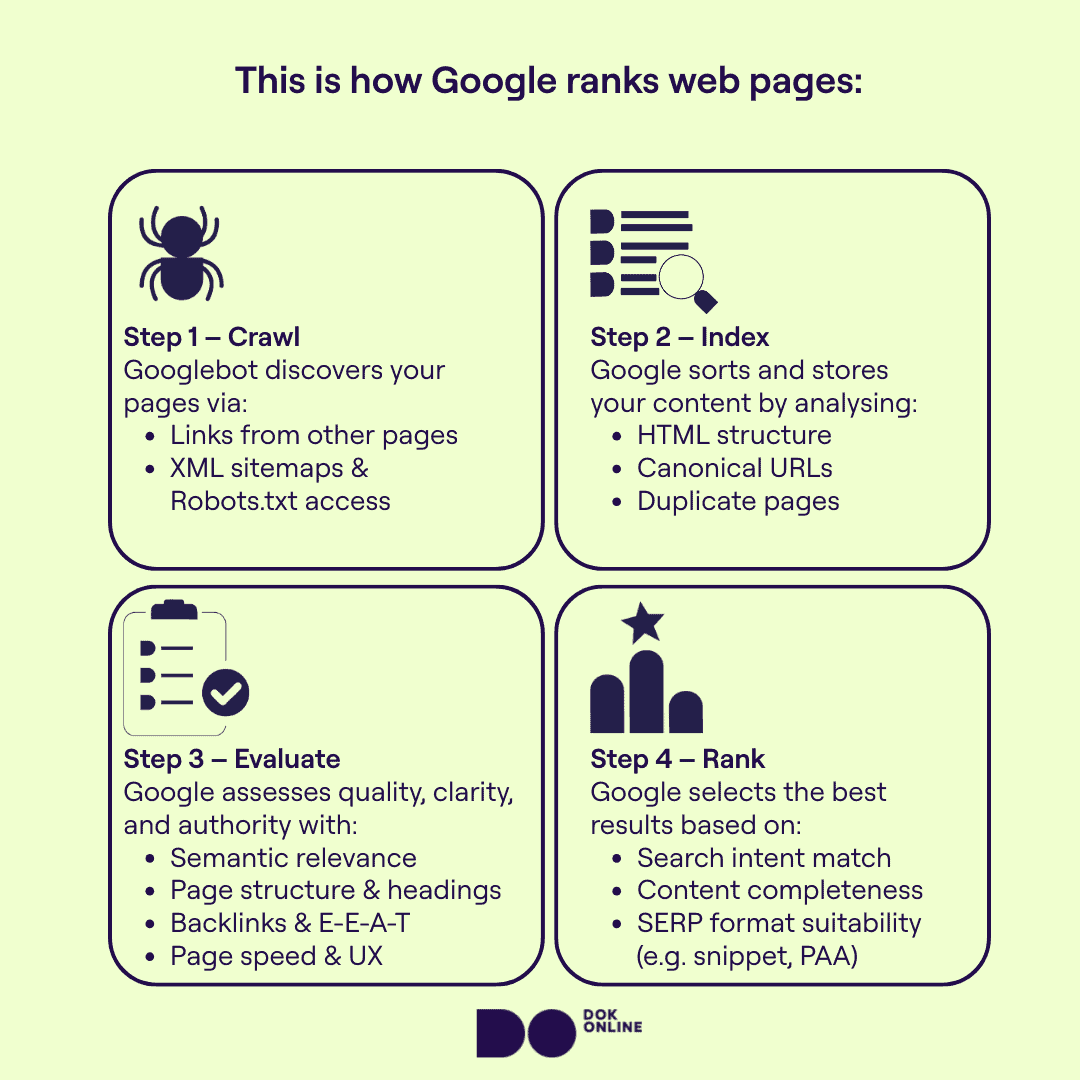
What do modern search results actually look like?
Search results today include a wide mix of formats, compared to just a list of blue links. Depending on the query, Google may show featured snippets, “People Also Ask” boxes, local map packs, product listings, video carousels, or knowledge panels. On top of these, AI-driven formats like Google SGE, ChatGPT, and Perplexity are now generating answers directly within the results page. These AI Overviews summarize content from multiple sources, often removing the need to click through.
This is where Search Engine Optimization (SEO) plays a bigger role.
It helps ensure your content is structured, clear, and associated with the right topics, so it can show up across all of these spaces. The goal is no longer just “ranking #1,” but becoming visible wherever users are getting their answers.
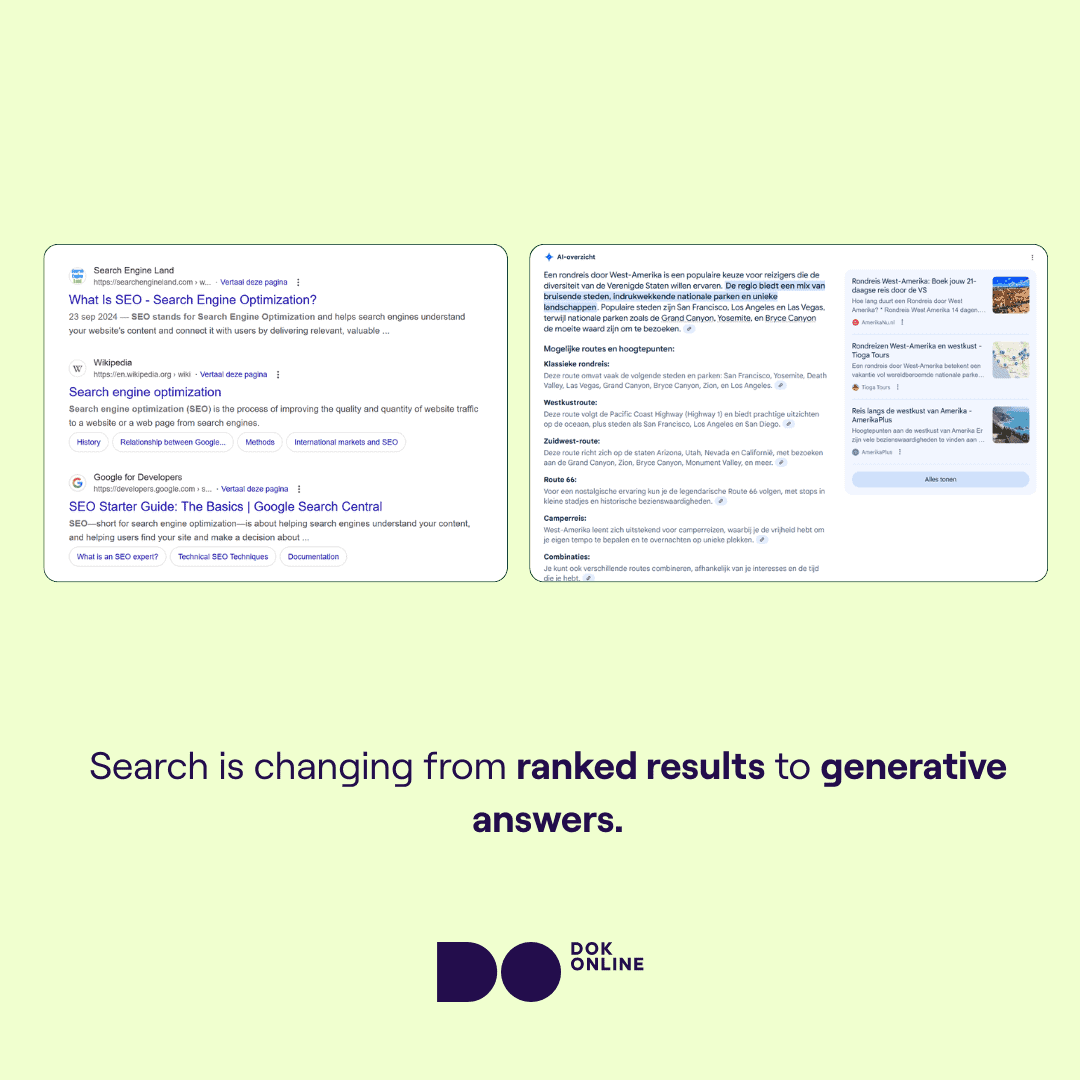
Why should you invest in SEO for your business?
SEO helps your business grow by making sure people can actually find you online. It’s the foundation of digital visibility, and when done right, it brings in the right traffic, builds brand recognition, and drives long-term results.
When your search engine optimization strategy is working at its best, here’s what you gain:
- Stronger visibility and branding: Your site shows up consistently across searches, reinforcing trust and recognition.
- Higher quality traffic: You attract visitors who are actively searching with clear intent to act or buy.
- Lower cost per lead: Unlike paid ads and paid search results, SEO doesn’t charge you per click, and results improve over time without increasing cost.
- Smarter decision-making: Search data reveals what your audience cares about, helping you improve content, UX, and marketing overall.
- Long-term impact: A solid SEO foundation keeps driving results, even if you pause other marketing activities.
If you’re not investing in SEO, you’re leaving visibility and revenue on the table. The whole world is online – your brand needs to be there too.
Future-proof your brand’s online visibility
We help you become the trusted answer to every question in your domain by increasing your visibility, traffic and trust across the board.
How does SEO work?
SEO works by making your website easier for search engines to find, understand, and trust. It’s built on three pillars that each support a different part of that process.
- On-page SEO focuses on the content itself, making sure it’s relevant, well-structured, and aligned with what users are searching for.
- Technical SEO ensures that your site is fast, accessible, and easy for search engines to crawl and index.
- Off-page SEO builds external signals of trust, like backlinks and brand mentions, to show that others value your content.
Together, these elements shape how visible your site becomes in search results. In the next sections, we’ll break down how each pillar contributes to that visibility.

1. On-Page SEO
On-page SEO includes all the actions you take within your website content to improve visibility in search engines. It focuses on creating pages that are relevant, well-structured, and clearly aligned with what people are searching for.
This includes:
- Writing content that matches user intent,
- Using clear headings (H1, H2, H3),
- Optimizing meta titles and descriptions,
- Linking internally,
- Using descriptive alt text for images,
- Keeping URLs short and readable.
These elements help both users and search engines understand your content faster and more accurately. At Dok Online, we treat this as the foundation of organic visibility. That’s why our team applies over 50 precision-based on-page checks when optimizing a single page – because relevance starts with getting the details right.
2. Technical SEO
Technical SEO focuses on the backend elements that help search engines access, crawl, and index your website effectively. It includes ensuring your site is mobile-friendly, loads quickly, and has a clear, crawlable structure. Key components include proper use of robots.txt, clean URLs, canonical tags, XML sitemaps, and schema markup. It also covers performance signals like Core Web Vitals and mobile responsiveness, which impact both visibility and user experience.
If your site is slow to load, misconfigured, or full of crawl barriers, search engines may not even include it in results. In AI-generated overviews, where engines summarize multiple sources instantly, technical SEO foundations matter. Your content needs to be machine-accessible and structured to even be considered.
3. Off-Page SEO
Off-page SEO refers to the signals that come from outside your website but influence how search engines evaluate authority and trust. While you can’t control every platform, you can influence these signals through targeted efforts that position your brand as a credible source in your niche across the web.
The point here is to shape your brand’s reputation in the eyes of both users and algorithms. Key components of off-page optimization include:
- Backlinks from authoritative websites: High-quality, relevant backlinks are still one of the strongest signals of trust. They show that other websites consider your content worth referencing.
- Brand visibility and social signals: Mentions on social media, digital PR, and brand recognition, even without links, help build authority and boost search relevance.
- Local business listings: For local SEO, platforms like Google Business Profile and directory consistency are critical. They validate your existence, location, and reputation across search surfaces.
These external signals help search engines determine whether your site is a trusted source. The more your brand is linked, mentioned, and consistently represented across the web, the more likely it is to appear in both traditional rankings and AI-generated results.
How to optimize your website for search engines in 7 steps?
Optimizing your website for search engines starts with turning SEO theory into action, step-by-step. These seven techniques for SEO cover the full process: from research and strategy to execution and ongoing improvement.
Each step is designed to align with how search engines actually evaluate content today.
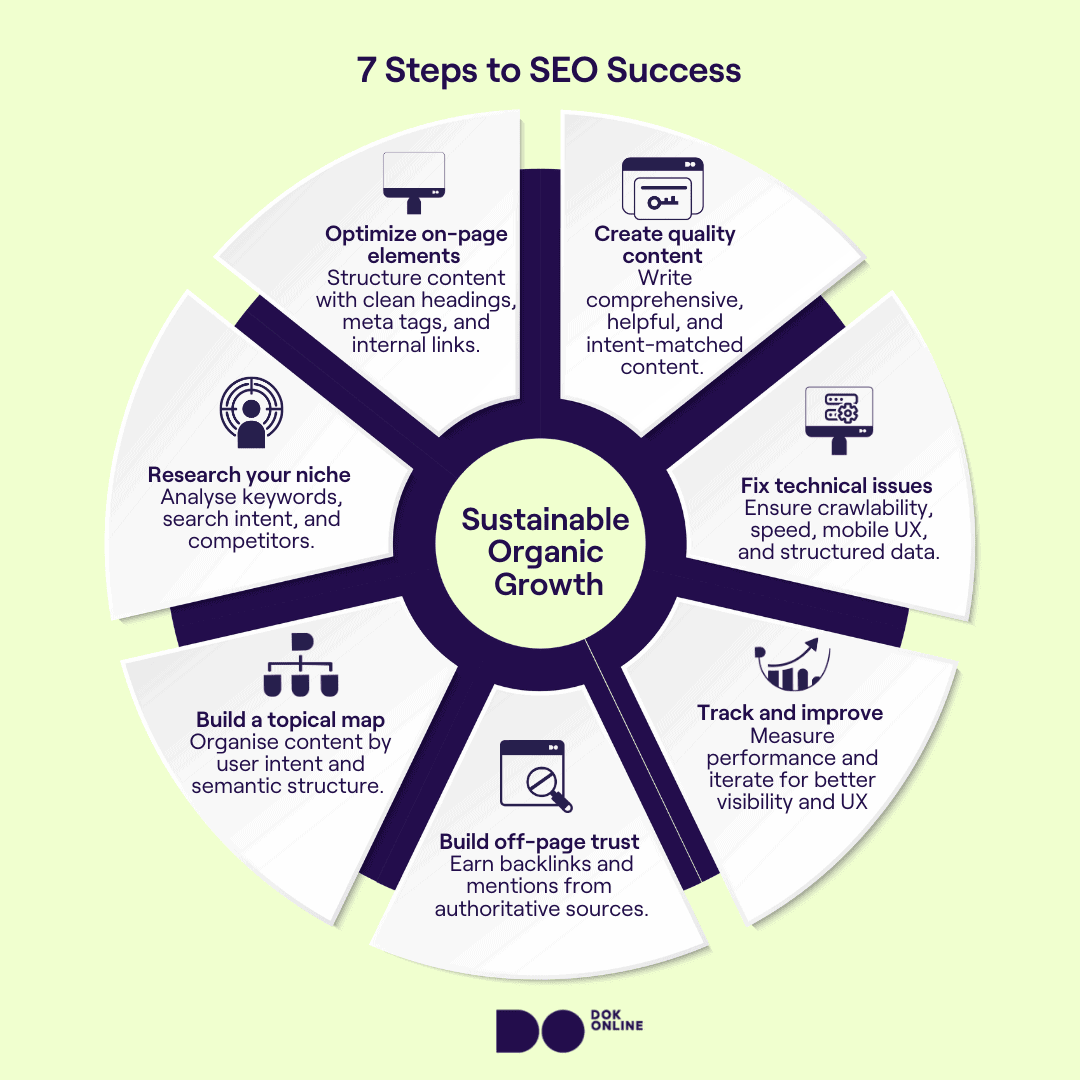
Step 1: Research your niche and search landscape
In the old days, conducting keyword research was step one in SEO. Now, it begins with understanding your niche, your audience, and the way people search. That means identifying relevant keywords, analyzing what shows up in the SERPs, and interpreting the intent behind each query.
Today, keyword research also opens the door to something deeper: uncovering the entities behind those keywords – core topics, subtopics, and concepts that define your business and help search engines understand your relevance in context. This is the essence of semantic SEO, where structure, meaning, and relationships matter more than individual keywords.
At this stage, the goal is to establish a foundation for strategic coverage. That includes:
- Discovering the language patterns and topics your audience consistently searches around
- Identifying which subjects are central to your offering, and which ones support it
- Analyzing how search engines structure the topic across SERPs
- Gathering the building blocks for a content system that builds topical authority, not just rank individual pages
This research becomes the input for your topical map: the framework that organizes your content thematically and semantically. That’s where step 2 begins.

Step 2: Build a topical map
A topical map turns your research into a structured content strategy. It outlines the key themes, subtopics, and internal pathways your site needs to cover in order to establish authority. Think of it as both a visual and strategic model for how your website should reflect expertise in the niche by listing out what pages.
To build a topical map, you start by identifying the core topics your website should be known for. These become your primary content pillars. From there:
- Break each topic into subtopics and supporting themes: Define the full scope of what users expect to learn under each topic, based on search behavior and entity associations.
- Assign keyword clusters to the right level in the hierarchy: Group keywords by intent and topical relevance, then connect them to the appropriate page type – whether it’s a pillar page, a subpage, or a supporting blog.
Use internal linking to define structure and authority: Link upwards to pillar content and sideways to related topics, creating clear relationships and reinforcing topical depth across the site. - Map content to user journeys and semantic context: Ensure each section of the map addresses a specific user need—whether informational, commercial, or navigational—and connects naturally with surrounding topics.
A well-built topical map prevents content overlap, strengthens your site’s internal architecture, and creates a semantic network that Google can easily parse.
This approach sits also at the core of how we work at Dok Online – we’ve developed and implemented custom topical maps for 50+ clients, helping them grow visibility through structured, scalable SEO.
Curious what your topical map could look like?
See the bigger picture of your SEO growth with a topical map that reveals what to publish, where to rank, and how to scale.
Step 3: Produce engaging, high-quality content
With your topical map in place, the next step is to create content that fully represents each topic – and does it better than what’s already out there. This means moving beyond surface-level coverage: content that only scratches the topic, misses key questions, or is built around one keyword instead of the full context.
High-performing pages go deeper. They answer the user’s query and the related questions that naturally follow. They explain how things work, compare options, clarify use cases, and support claims with examples, stats, or expert insight.
Effective SEO copywriting reflects full topical understanding. That includes adhering to certain, what we at Dok Online like to call, copywriting rules. Here’s a glimpse of what we practice for all our clients:
- Cover related terms naturally: Use semantically linked words, questions, and subtopics to improve contextual relevance and match how users search.
- Structure for search behavior: Organize content with clear headings, consistent formatting, and logical flow that mirrors how people explore information online.
- Write in simple language: Keep content easy to understand for both users and search engines. Use plurals (e.g., “camping tents”) and quantify where possible with examples (e.g., “5+ brands like Amazon, Bol, and Shopify…”) to strengthen semantic range.
- Build trust with clarity: Be accurate, specific, and complete. Avoid filler, vague statements, or keyword stuffing that disrupts the user experience.
- Add helpful supporting content: Include FAQs, tables, images, and real-world use cases to deepen understanding and serve different user intents on the same page.
- Link internally to related content: Use natural internal links to nearby topics in your cluster to reinforce structure, improve crawlability, and strengthen your topical map.
This is how you build topical authority in practice. Elements like these help your content match a wider range of search queries and user expectations. Google doesn’t just evaluate one page in isolation. Instead, it looks at how well your entire site covers the subject.
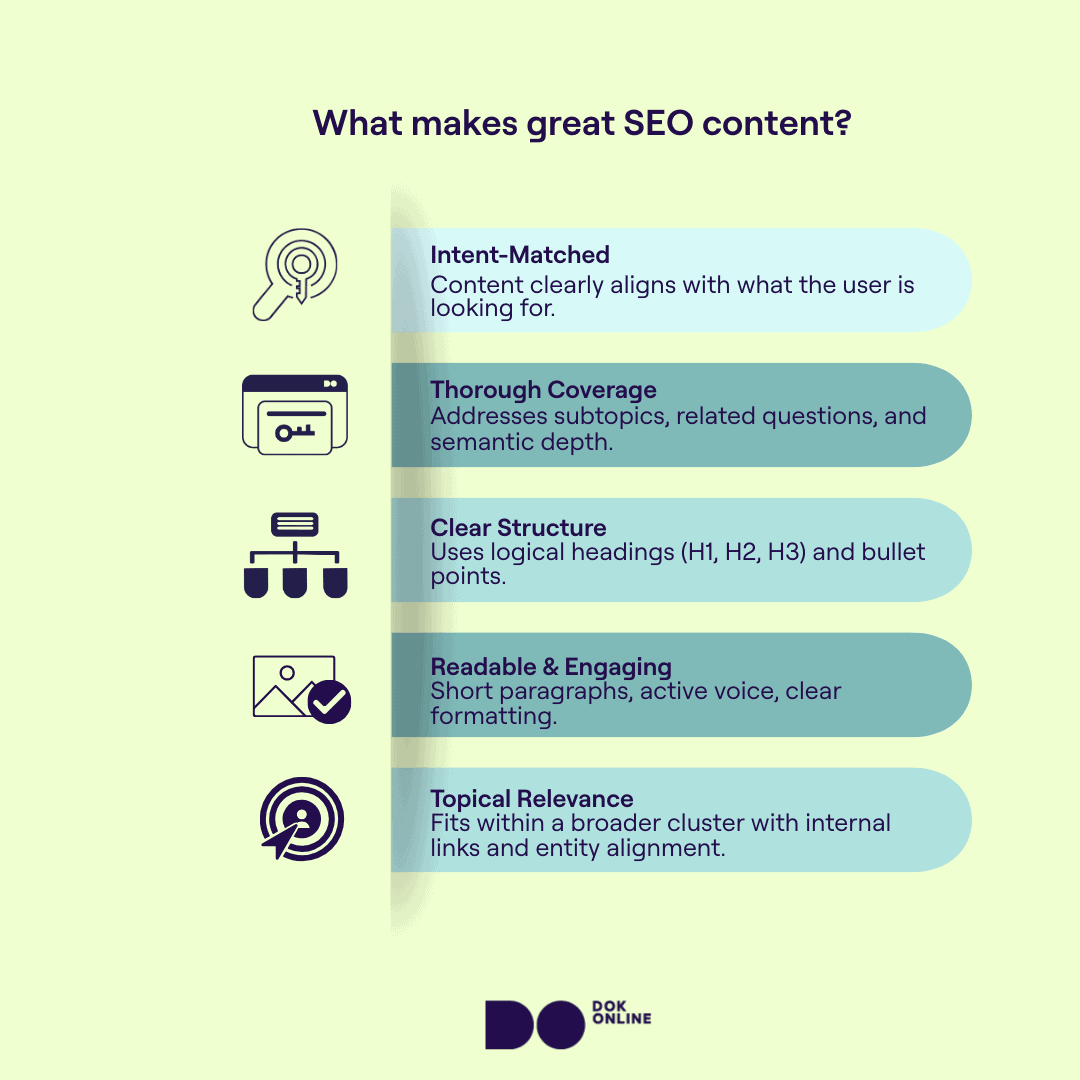
Step 4: Optimize on-page SEO elements
Once your content is written, the next step is to make it technically ready for search engines to crawl, parse, and understand. On-page SEO focuses on how your content is presented in the code – using clear, consistent signals that help algorithms evaluate relevance and structure.
Start with your meta title and description: these should summarize the content clearly, include your target keyword, and align with user intent. Apply a single H1 tag for the main topic, then use H2s and H3s to organize content logically. Proper heading markup helps web crawlers understand how your content is structured.
Here are additional on-page SEO steps to implement:
- URLs: Use short, descriptive URLs that reflect the page’s topic and follow a consistent, scalable structure.
- Images: Use compressed, web-optimized images (preferably under 100 KB) in WebP or modern formats. Give files descriptive names and add alt text that reinforces the page’s semantic context.
- Anchor text: Use clear, keyword-aligned anchor text when linking internally to relevant pages. Avoid generic phrases like “click here” and instead describe what the linked page is about.
- External links: Add outbound links to credible, high-authority sources where relevant, especially when citing statistics, references, or definitions.
These on-page elements make your content structurally sound, ready to be discovered, indexed, and ranked with confidence.
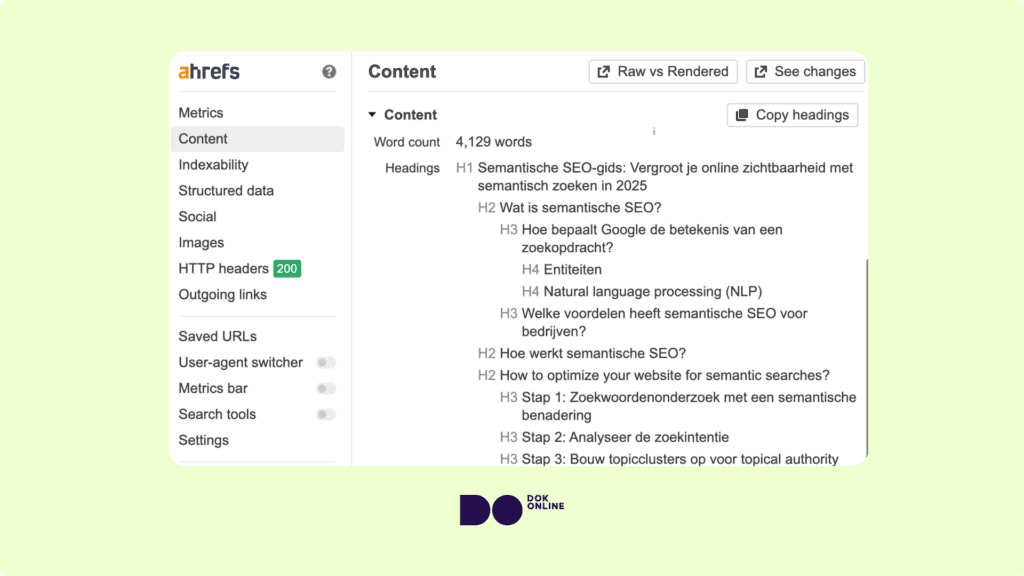
Step 5: Analyze your website technicals
Technical SEO removes the roadblocks that prevent search engines from reaching, rendering, and ranking your pages. It focuses on the behind-the-scenes infrastructure: how your website is built, how fast it loads, and how reliably it can be indexed and served across devices.
Here’s what you should review when technically analyzing websites for search engines:
- Crawlability: Ensure your robots.txt file and XML sitemap are correctly configured to guide crawlers without blocking key pages.
- Index management: Use canonical tags to signal preferred URLs and avoid duplication across your site.
- URL structure: Keep URLs short, consistent, and readable for both crawlers and users.
- Mobile readiness: Make sure the site renders cleanly across screen sizes, with no intrusive popups or layout shifts.
- Site speed and Core Web Vitals: Optimize server response time, defer non-critical scripts, and compress assets to meet Google’s performance thresholds.
- Structured data: Use schema markup to help search engines better understand the content type, page structure, and key details.
When these technical foundations are in place, your content becomes usable at scale. A well-optimized backend ensures Google can reliably access your pages, trust their structure, and serve them with confidence across every device and result format.
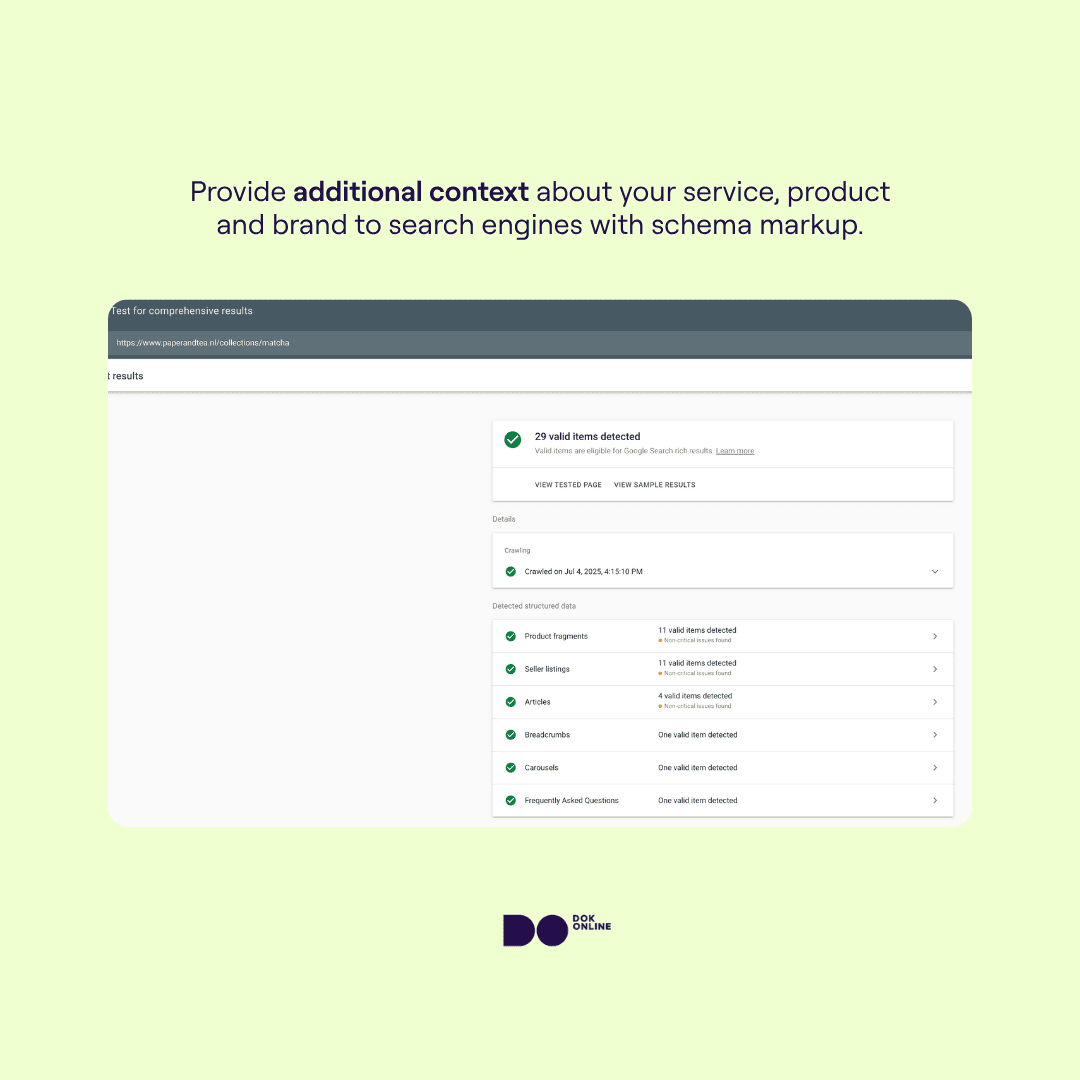
Great content deserves to be seen
Don’t let backend problems sabotage great content. We fix the technical foundation, so your SEO can thrive.
Step 6: Earn trust & authority through off-page signals
Off-page SEO is how search engines gauge your reputation beyond your website. It’s no longer just about how many sites link to you. It’s about who they are, how relevant they are to your business, and how your brand is talked about across the web.
Backlinks from high-authority sources still matter – but they’re now just one part of a broader trust profile. Google’s systems are increasingly influenced by signals like brand presence, mentions, consistency, and real-world credibility. A single link from a well-known industry publication may outweigh dozens of low-context mentions.
Authority now comes from being referenced and cited; these are the principles we follow in the new age of off-page SEO:
- Backlink quality: Earn backlinks from relevant, authoritative sources through digital PR, data-driven content, interviews, or strategic partnerships – not spam or mass guest posting.
- Brand mentions: Get your brand referenced (linked or unlinked) on trusted sites. Mentions from high-authority domains can strengthen your entity profile even without a backlink.
- Directory consistency: Ensure your business details (name, address, phone number, descriptions) are accurate and consistent across NAP directories like, Yelp, Crunchbase, and Apple Maps.
- Google Business Profile: Keep your profile active and up to date, with correct contact info, regular updates, and photos to improve visibility in local packs and map results.
- Review signals: Encourage satisfied customers to leave reviews on Google, Trustpilot, industry-specific directories, and other high-trust platforms. Monitor and respond to them regularly.
Strong off-page signals show that your brand is recognized, referenced, and trusted. Search engines use that reputation to decide whether your site should be referenced in the search results or their answer overviews.
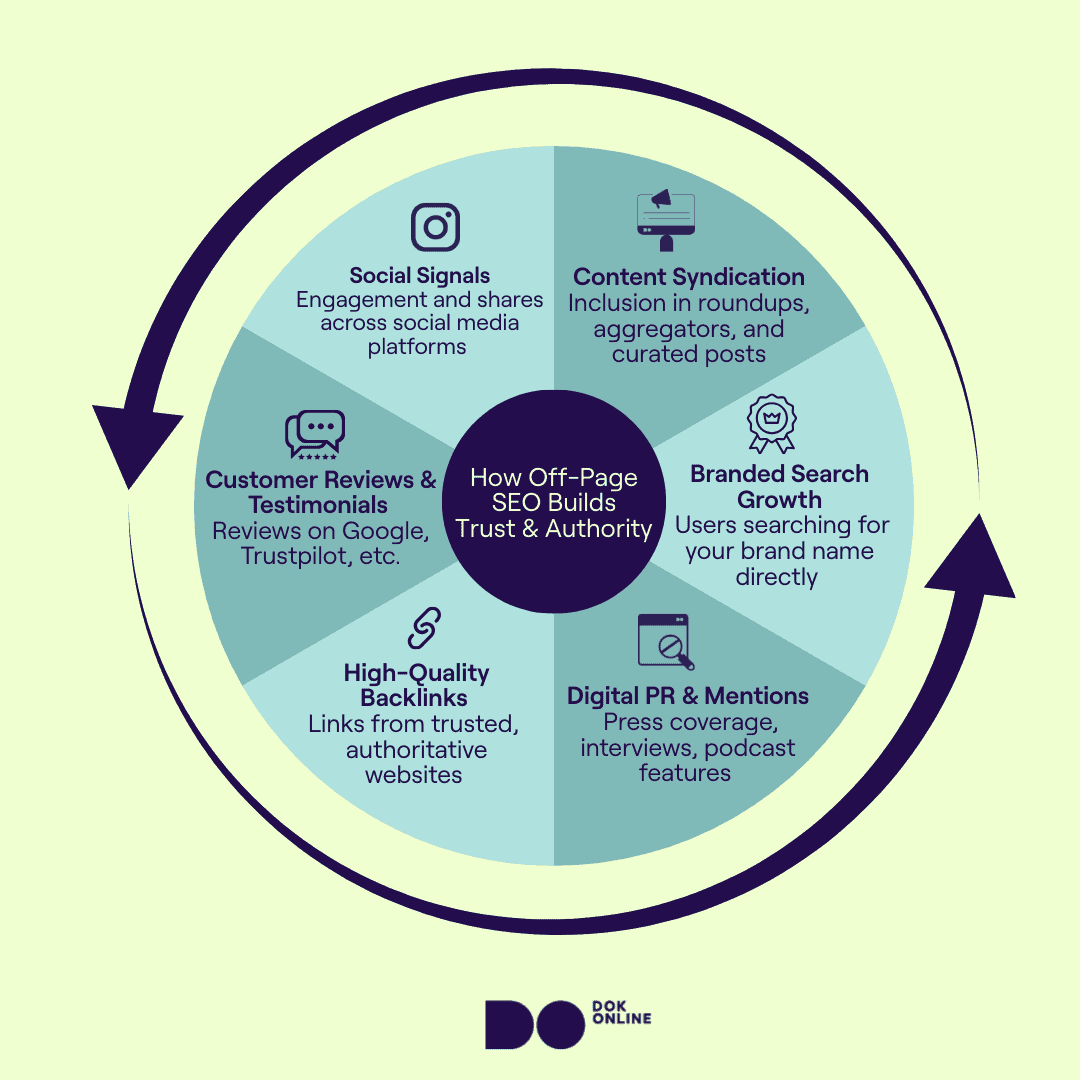
Step 7: Track your performance
SEO is an ongoing process of refinement. To understand what’s working and where to improve, you need to monitor performance through both technical and user-focused metrics. More importantly, these metrics must align with your actual business goals – whether that’s growing visibility, generating leads, or increasing conversions.
Key areas to track and analyze are:
- Organic traffic: Use tools like Google Analytics and Google Search Console to track how many users land on your site through unpaid search.
- Keyword rankings: Monitor your visibility for target terms and track changes across core topic clusters, rather than isolated keywords.
- Engagement signals: Watch metrics like bounce rate, time on page, and scroll depth to evaluate content relevance and UX.
- Conversion performance: Measure form submissions, downloads, purchases, or other goal completions tied to organic sessions.
- Content gaps: Use SERP analysis and content audits to find underperforming pages, overlapping topics, or missing subtopics.
- Technical issues: Run regular crawls (e.g., via Screaming Frog or Sitebulb) to flag indexing errors, broken links, or Core Web Vitals regressions.
Staying visible in search means staying active through regular testing, iteration, and refinement.
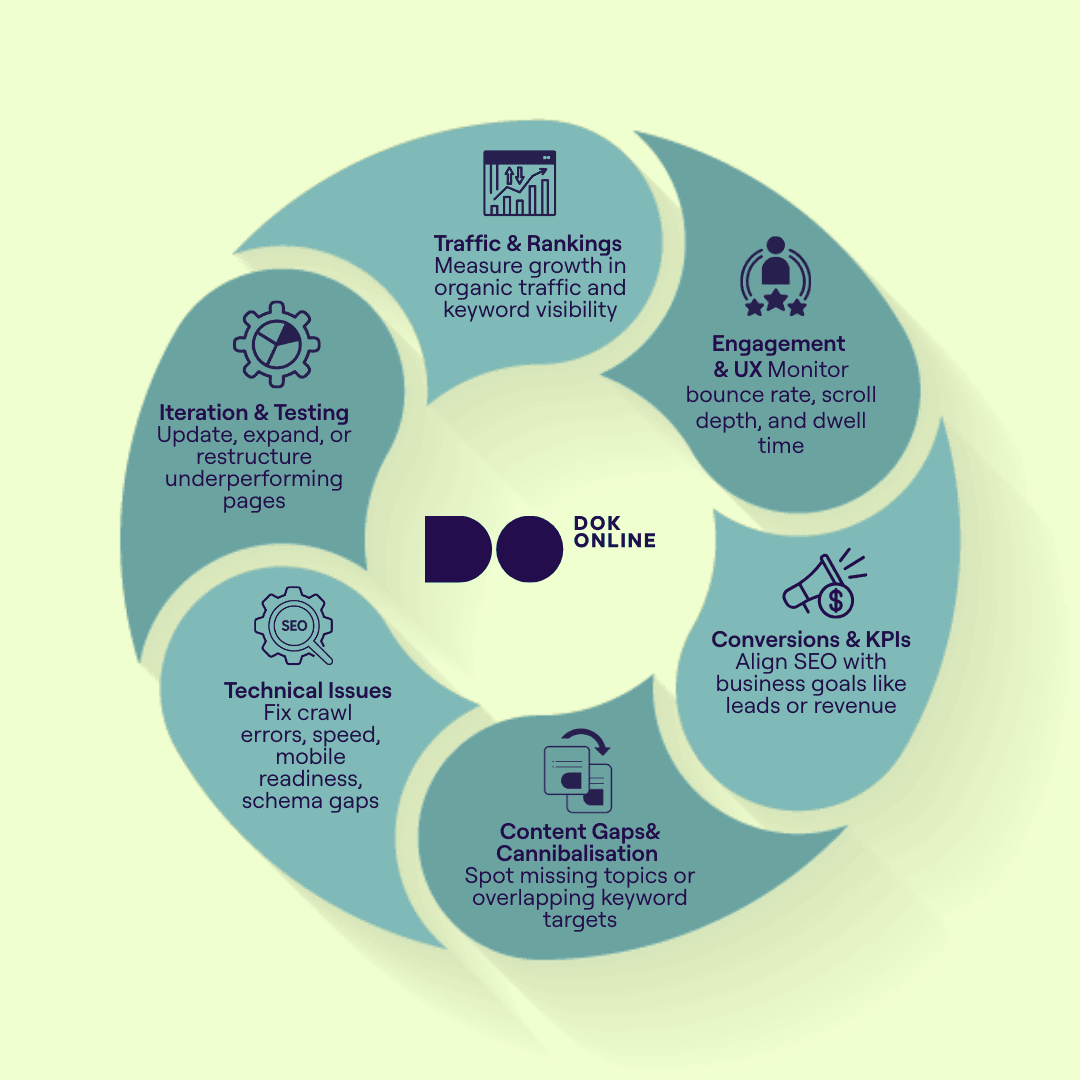
What are the common mistakes in SEO?
Common mistakes in SEO include targeting the wrong keywords, neglecting technical foundations, or chasing backlinks without a clear strategy. Getting SEO right means avoiding the pitfalls just as much as applying the right tactics.
Here are seven mistakes to avoid:
- Creating duplicate content: Reusing copy across pages, without unique value or canonical tags, confuses search engines and splits ranking signals.
- Targeting irrelevant or vague keywords: Optimizing pages for terms that don’t match user intent leads to low traffic quality and poor engagement.
- Ignoring topical structure: Publishing isolated content without a clear internal hierarchy or topical map weakens your authority and discoverability.
- Building low-quality backlinks: Acquiring links from irrelevant, spammy, or low-trust sites can harm credibility and lead to manual actions.
- Neglecting internal linking: Failing to connect related pages breaks topical flow and makes it harder for crawlers to follow your content network.
- Overlooking technical basics: Issues like slow site speed, broken links, mobile errors, and crawl blocks can prevent even great content from ranking.
- Publishing without a strategy: Creating content without a topical strategy, keyword focus, or SEO objective leads to fragmentation and wasted effort.
How long does SEO take to work?
Most businesses begin seeing initial SEO results within 3 to 6 months, with stronger gains between 6 and 12 months. Timelines depend on your site’s age, competition, and domain authority. SEO takes time because Google must assess your site’s trustworthiness and topical depth – especially for competitive terms.
How much does SEO cost?
The cost of SEO for small to mid-sized businesses typically ranges from € 1,500 to € 5,000 per month, depending on goals, complexity, and deliverables. This includes several aspects of how SEO works: content, research, technical fixes, link-building or performance tracking.
At Dok Online, SEO campaigns start at € 5,000 and scale up to € 20,000+ per month for full-service execution. We offer long-term value through tailored strategies, deep expertise, and a proven track record across industries.
What are the different specializations in SEO?
The main specializations in SEO are Local SEO, E-commerce SEO, Enterprise SEO, International SEO, and News SEO. Each focuses on different ranking goals, technical setups, and user journeys – depending on the business model, website type, and target audience.
- Local SEO: Helps local businesses rank in map packs and location-based searches using Google Business Profile, citations, and local keywords.
- E-commerce SEO: Optimizes online stores for visibility and conversions across category pages, product listings, and filters. Requires strong site architecture and schema.
- Enterprise SEO: Manages large, complex websites at scale—often across departments. Focuses on automation, governance, and site-wide coordination.
- International SEO: Targets multiple regions or languages with hreflang, geo-targeting, and country-specific content structures.
- News SEO: Tailored for publishers. Focuses on speed, structured data, and freshness to appear in Google News and Top Stories.
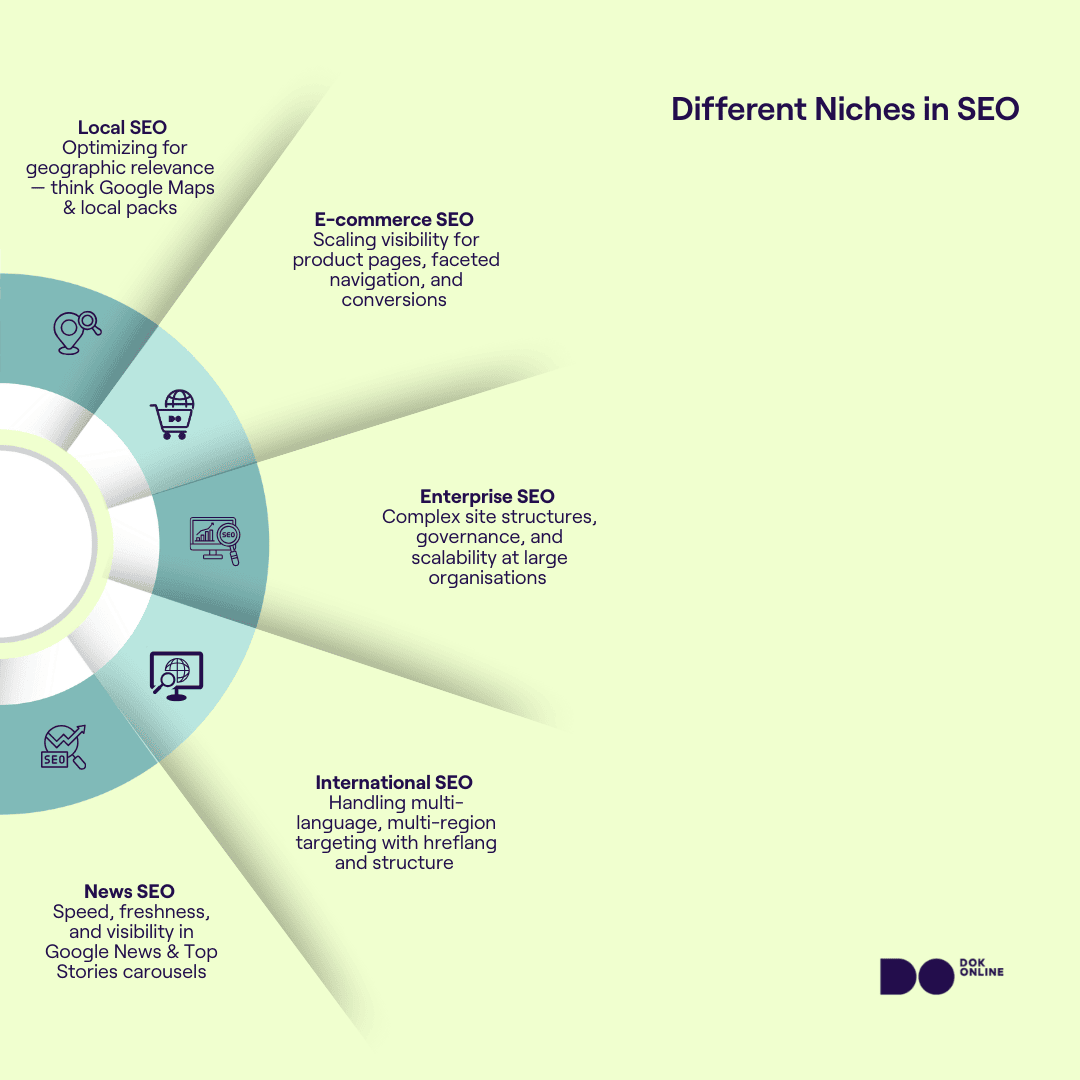
Ready to unlock your site’s SEO potential?
Want to know which SEO efforts actually move the needle? Let us show you, with insights tailored to your website.
What are the differences between SEO and SEM?
The differences between SEO and SEM are based on how visibility is earned versus paid for. SEO focuses on increasing your site’s visibility through organic rankings, using strategies like content creation, technical optimization, and link building. SEM (Search Engine Marketing), on the other hand, includes paid advertising methods like Google Ads or Bing Ads to appear instantly in search results.
SEM delivers faster visibility but stops the moment your budget runs out. SEO takes longer to build but generates long-term, compounding results. Both can be used together, but they require different strategies, timelines, and skill sets. SEM is budget-driven and campaign-based, while SEO is system-driven and foundational.
| Feature | SEO | SEM |
| Traffic Type | Organic search traffic | Paid search traffic |
| Timeline | Slower to build (3–6+ months) | Instant visibility |
| Cost Structure | Time, tools, and resources | Pay-per-click (PPC) |
| Long-term ROI | Compounding, sustainable | Stops when ad budget ends |
| Placement | Earned rankings (below ads) | Sponsored listings (top of SERPs) |
| Control | Limited control over SERP placement | Full control over targeting & copy |
| Best For | Long-term growth & authority | Short-term campaigns & quick wins |
Examples of SEO: Dok Online case studies
We’ve helped dozens of businesses grow their organic visibility through structured, scalable SEO strategies. From niche travel brands to high-competition ecommerce platforms, our clients have seen measurable growth in traffic, rankings, and conversions.
See how we helped AmerikaNu dominate the travel niche, or explore more SEO case studies to see what’s possible when strategy, structure, and execution align.
The future of SEO and AI
As search becomes AI-first, visibility shifts from position to presence. Google is already testing AI Overviews in multiple countries. Bing integrates generative answers through ChatGPT. Platforms like Perplexity are gaining traction by surpassing search engines altogether. In these new environments, search engines pull from trusted, well-structured sources – not just ranked pages, and cite them in AI-generated answers.
Businesses that fail to adapt to this new shift risk being excluded from the answers entirely. And doing so requires semantic clarity, topical authority, and technical readiness across your entire site.
That’s why we’ve built Generative Engine Optimization (GEO) into our core SEO strategy. At Dok Online, we help clients structure their content to be understood, surfaced, and referenced by both users and algorithms.
How Dok Online can help you rank better on Google
As SEO specialists, we combine strategic planning with hands-on execution – content optimization, on-page structure, internal architecture, and technical performance. Our process covers everything: from topical maps and entity alignment to Core Web Vitals, schema, internal linking, and semantic content writing.
Whether you’re an ecommerce business, a SaaS company, a local service provider, or a content-led brand, we’ve helped companies like yours grow, rank, and stay relevant.
Take your rankings to the next level
Whether you’re stuck on page 2 or ready to scale, we help you claim the top positions with a clear, data-driven plan. Let’s align on your goals and show you what’s possible.